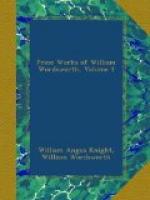Lakes (which is most strongly felt in the summer season)
is an over-prevalence of a bluish tint, which the green
of the herbage, the fern, and the woods, does not
sufficiently counteract. If a house, therefore,
should stand where this defect prevails, I have no
hesitation in saying, that the colour of the neighbouring
rocks would not be the best that could be chosen.
A tint ought to be introduced approaching nearer to
those which, in the technical language of painters,
are called
warm: this, if happily selected,
would not disturb, but would animate the landscape.
How often do we see this exemplified upon a small
scale by the native cottages, in cases where the glare
of white-wash has been subdued by time and enriched
by weather-stains! No harshness is then seen;
but one of these cottages, thus coloured, will often
form a central point to a landscape by which the whole
shall be connected, and an influence of pleasure diffused
over all the objects that compose the picture.
But where the cold blue tint of the rocks is enriched
by the iron tinge, the colour cannot be too closely
imitated; and it will be produced of itself by the
stones hewn from the adjoining quarry, and by the
mortar, which may be tempered with the most gravelly
part of the soil. The pure blue gravel, from the
bed of the river, is, however, more suitable to the
mason’s purpose, who will probably insist also
that the house must be covered with rough-cast, otherwise
it cannot be kept dry; if this advice be taken, the
builder of taste will set about contriving such means
as may enable him to come the nearest to the effect
aimed at.
The supposed necessity of rough-cast to keep out rain
in houses not built of hewn stone or brick, has tended
greatly to injure English landscape, and the neighbourhood
of these Lakes especially, by furnishing such apt
occasion for whitening buildings. That white should
be a favourite colour for rural residences is natural
for many reasons. The mere aspect of cleanliness
and neatness thus given, not only to an individual
house, but, where the practice is general, to the whole
face of the country, produces moral associations so
powerful, that, in many minds, they take place of
all others. But what has already been said upon
the subject of cottages, must have convinced men of
feeling and imagination, that a human dwelling of
the humblest class may be rendered more deeply interesting
to the affections, and far more pleasing to the eye,
by other influences, than a sprightly tone of colour
spread over its outside. I do not, however, mean
to deny, that a small white building, embowered in
trees, may, in some situations, be a delightful and
animating object—in no way injurious to
the landscape; but this only where it sparkles from
the midst of a thick shade, and in rare and solitary
instances; especially if the country be itself rich
and pleasing, and abound with grand forms. On
the sides of bleak and desolate moors, we are indeed
thankful for the sight of white cottages and white




